Louvre (Louvre)
The Louvre is a famous royal palace in Paris which currently houses the world’s largest museum. It is situated in the center of Paris, on the right bank of the River Seine between the Quai de Tuileries, the Quai du Louvre, the Rue de l’Amiral-Coligny, the Rue de Rivoli, and the Avenue du Général-Lemonnier. Nowadays, the Louvre is a grand architectural ensemble which stretches for 600 meters along the Seine and comprises buildings dating from the period between the 12th and 20th centuries.
The Louvre was founded by order of King Philip II August in 1190 as a fortress in the western outskirts of the city. Initially, it was used as a prison and storage of royal treasures and archives. In 1360, it became the royal residence and originally looked like a fortified castle. In the 16th-17th centuries under Kings Francis I, Henry II, Charles IX, Henry IV, Louis XIII and Louis XIV, the efforts of architects Pierre Lescot (in collaboration with sculptor Jean Goujon), Jacques Lemercier, Louis Le Vau, Claude Perrault, and others transformed the Louvre into a grand palace combining features of Renaissance architecture (the Cour Carée (square courtyard)) and the Classicism style (the Eastern Façade). The Grand Gallery was built along the Seine to connect the Louvre with the Tuileries Palace which was founded in 1564. However, after Louis XIV chose Versailles as the royal residence in 1682, the Louvre gradually fell into neglect (it was only under Napoleon I that the construction of the palace resumed).
When Peter I visited Paris in 1717, the Louvre still had residential quarters and some of those were offered for the accommodation of the Russian Tsar and his entourage. The Palace still had the Royal Library and some of the King’s collection of paintings. At the same time, it housed numerous institutions, such as the Royal Academy of Sciences, the French Academy (Académie Française which did studies pertaining to the French language and published dictionaries), the Royal Academy of Painting, the Royal Academy of Architecture, the Royal Academy of Inscriptions and Medals, and the Royal Printing House. The ground floor of the Grand Gallery in the Louvre was occupied by the Mint and studios of sculptors, artists and craftsmen. The Palace also had apartments of courtiers, priests, artists and craftsmen of the King who, along with their families and servants, made up the motley population of the former royal residence.
At that time, the northern wing of the Louvre (the Aile Richelieu, etc.) did not exist and the palace was virtually surrounded by closely adjacent medieval buildings in the east and north. A small open space (the Louvre Square) only existed in front of the western façade of the Old Louvre. The Cour Carrée was filled with flimsy dwellings of craftsmen and artists. The portion of the Palace that formed the northern side of the Cour Carrée did not have a roof. The Eastern Façade was also incomplete.
About 9 o’clock in the evening on April 26/May 7, 1717, Peter I and his entourage, who had arrived at Paris a day before, came to the Louvre where he was supposed to stay in the show apartments (under the Apollo Gallery) previously occupied by the Queen Mother. He was offered the “richest and most beautiful bed in the world” which had been once ordered for the Sun King by Madame de Maintenon. Two tables for 60 persons each were set in one of the halls. The luxury furnishings and a huge number of burning candles in the chandeliers and girandoles literally blinded the Tsar, but did not give the impression that the hosts wished them to give. Peter viewed the luxury rooms and ate only a bit of the royal treats — he asked for a piece of bread and turnip, tried five or six sorts of wine and drank two glasses of beer, but he did not want to stay in the Louvre which he “did not like because of its grandeur”.
Possibly, on the very first day of his visit to Paris (April 30/May 11, 1717), Peter I wished to see “where all kinds of copper statues were cast” (i.e. the workshops on the ground floor of the Louvre’s Grand Gallery) after he had viewed the equestrian statues of kings. He also visited the workshops of royal carpenters and joiners, showed interest in different joinery tools, and even demonstrated his carpentry skills to the French.
According to his Journal, on May 3/14, 1717, the Tsar took a closer look at the institutions situated in the Louvre: “He visited the Grand Gallery with its best paintings and viewed models of the best fortresses in another large gallery, and then he visited the Louvre where statues were made”. Accompanied by the Duke d’Antin, the Tsar visited the Royal Academy of Painting and Sculpture where Director Antoine Coypel, the first King’s painter, gave them explanations of paintings. However, Peter was not much into works of French painters of the time. Instead, he was much more interested in the scale models (“relief plans”) of all the fortresses in the Kingdom. He spent a long time studying them and talking to military professionals, such as the Marquise d’Asfeld, a member of the Military Council in charge of building fortifications, Marshal de Villars and others. According to Saint-Simon, the Tsar “visited many rooms in the Louvre”, including a sculptor atelier on the ground floor of the Gallery.
The next visit of Peter I to the Louvre was on May 17/28 when he, accompanied by Marshal de Tessé, acquainted himself with the Mint (Monnaie des Médailles) which occupied “four arcades under the Grand Gallery”. The Tsar minted three coins by himself. On June 1/12, Peter visited the Mint again, where he was welcomed by Director Nicolas de Launay. A medal with the portrait of the Tsar was minted in his presence. The medal was designed by the Academy of Inscriptions. One side of the coin had the portrait of the Tsar wearing armor and mantle and the other had the image of goddess Slava hovering in the beams of the sun and an inscription reading: “Vires acquirit eundo” — a Vergil quotation which translates as “We gather strength as we go” in reference to the benefits of the Tsar’s travels. The portrait of Peter was based on a drawing made by Jean Duvivier who sheltered himself among those accompanying the Tsar in order to discreetly make sketches. The medals were immediately given to the Tsar (the golden medal) and his entourage (silver medals). Peter showed keen interest while examining new presses for stamping medals. During the same visit, the Tsar visited a jeweler atelier producing silverware.
On June 1/14, 1717, Peter I visited the Royal Printing House in the Louvre where he was shown a variety of proof impressions.
On June 8/19, 1717, the Tsar visited the Royal Academy of Sciences. It was located “in the former King’s apartments in the old Louvre”. The distinguished guest was welcomed by the President of the Academy Abbot Bignon and his colleagues: “the academicians came out to greet the Tsar right at the stairs”. Then scientists showed their scientific achievements, including a model of a machine for lifting water with minimum effort; outstanding outcomes of chemical experiments; drawings for the Descriptions of the Arts and Trades which were ready for printing; and finally, the Tsar was shown a new hand jack design. Famous René Antoine de Réaumur was one of those who demonstrated the scientific achievements to the Russian Tsar. The Tsar asked the academicians to be seated rather than standing during the scientific performance. Later, on December 22, 1717, Peter I was elected as a member of the French Academy of Sciences and in 1721, he sent the scientific community a new map of the Caspian Sea, for, as he himself put it, “Up until this point, there has not been any true map of the Caspian Sea”. The visit of Peter I to the French Academy of Sciences laid the foundation for establishing strong scientific relations between Russia and France.
On the same day, the Tsar visited the Academy of Inscriptions and Medals which was also located in the Louvre. It was founded under Louis XIV with the view “to communicate the true idea of the greatness of France to the descendants” (creating inscriptions, mottos and legends for medals and monuments). Here, Peter was shown the medals representing the history of Louis XIV. In turn, the Tsar showed medals related to the events that occurred during his reign. Later, in 1719, Peter sent the academicians an inscription designed for his equestrian statue and then the old mysterious inscriptions found with the Kalmyks, asking for their opinion about them.
On the next day, June 9/20, the Tsar stated his willingness to visit the Mint and take one more look at the medals representing the history of Louis XIV. This time, he was complimented with a medal depicting young Louis XV.
On May 17/28, 1717, Peter I visited the Royal Library. However, it is not exactly known where the Russian Tsar viewed the book treasures of the French Kings. His Journal concisely states that “On the 17th day, His Majesty went to see the King’s Study at the Tuileries”. At the same time, the Description of Paris (Description de la ville de Paris) by Germain Brice (1717) says that the Royal Library and the King’s study were situated in the Louvre. Historian Jean Porscher believed that Peter had visited the Royal Library “which was then situated in the Rue Vivienne, opposite the today’s garden”. Given that the Tsar combined his visit to the Library with visiting the Mint, it may be concluded that he visited both the Louvre and the Tuileries Palace which comprised a single complex at the time.
Accompanied by Prince Kurakin and Vice-Chancellor Shafirov, Peter arrived at the Library at 11 o’clock in the morning. The royal librarian Abbot de Louvois showed him a lot of ancient Greek manuscripts decorated with miniatures. According to an eyewitness, the Tsar kissed some of those with respect. He was also shown France’s historical antiquities that were kept in the Library, such as the tomb of Childeric, the father of Clovis, and items found in it: a signet ring, a golden axe, Roman coins, etc. The author emphasized that the Tsar had not given any present to the Library, nor did he mention about any present given to the Tsar. However, according to Jacob Stählin, when visiting the Library, the Monarch was given “twelve very large books sized as “Alexandrian” sheet and bound in morocco with gilt decorations, such as the best engravings of the royal buildings and gardens in Versailles and the trips of Louis XIV drawn by famous Von der Malen (Adam Frans van der Meulen was the court battle painter to Louis XIV — S.M.) and engraved on copper by the best artists in Paris”.



